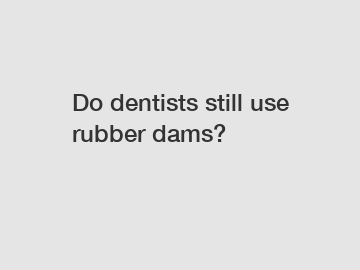Do dentists still use rubber dams?
Do dentists still use rubber dams?
The use of rubber dams in dentistry has been a long-standing practice, offering various benefits and advantages. However, with advancements in technology and evolving dental techniques, one may wonder if dentists still use rubber dams. Let's delve into this question and explore the importance of rubber dams in modern dentistry.
1. The Purpose of Rubber Dams: .

Rubber dams are thin sheets made of latex or non-latex material that isolates and protects the teeth being worked on. They serve as a barrier, preventing saliva, blood, and debris from entering the treatment area. By keeping the tooth dry and isolated, dentists can achieve better visibility and maintain a sterile environment during various dental procedures.
2. Improved Patient Experience:
Rubber dams not only benefit the dentist but also improve the patient's experience. The dam acts as a shield, protecting the soft tissues of the mouth from chemicals, dental instruments, and materials used during treatment. Additionally, patients may feel more comfortable and relaxed knowing that their treatment area is properly isolated, reducing the chances of accidental ingestion or aspiration.
3. Infection Control Measures:
In recent times, infection control has become a primary concern in healthcare settings. Rubber dams play a crucial role in preventing cross-contamination between patients by minimizing the spread of bacteria and viruses present in saliva or blood. The use of rubber dams ensures a higher level of infection control and helps maintain a safe environment for both the dentist and the patient.
4. Rubber Dams and Restorative Procedures:
Rubber dams are particularly valuable during restorative procedures such as dental fillings and crown preparations. The isolation provided by the dam aids in achieving optimal bond strength and ensures a clean working area, free from contamination. When placing composite fillings, rubber dams help prevent moisture interference, leading to better adhesion and longevity of the restoration. Similarly, for crown preparations, rubber dams facilitate accurate tooth preparation and impression-taking.
5. Endodontic Treatments:
Rubber dams are widely used during endodontic procedures, such as root canal treatments. These procedures involve cleaning and shaping the root canal system, followed by filling it with a biocompatible material. Using a rubber dam prevents oral bacteria and debris from contaminating the canal, reducing the risk of failure or reinfection. It also protects the patient's airway by preventing accidental ingestion or aspiration of endodontic instruments or materials.
6. Challenges and Alternatives:
While rubber dams offer numerous advantages, there are challenges associated with their use. Some patients may feel uncomfortable wearing them, especially if they have a severe gag reflex. In such cases, dentists may opt for alternatives like isolation devices, suction devices, or advanced intraoral cameras to achieve a similar level of isolation and visibility.
7. Future Trends:
Despite the challenges, rubber dams continue to be widely used in dentistry. However, with ongoing advancements, we may witness the emergence of new isolation techniques that offer improved patient comfort and effectiveness. Dental professionals are constantly exploring innovative methods to enhance isolation and maintain a clean and dry treatment environment.
In conclusion, rubber dams remain essential in modern dentistry due to their ability to isolate and protect the treatment area, improve infection control measures, and enhance the patient's overall experience. Although challenges and alternative techniques exist, their widespread usage underscores their significance. The dental community will likely continue to rely on rubber dams while also embracing potential future advancements aimed at further improving patient care and comfort. So, the next time you find yourself in a dental chair, you may just see a rubber dam in place, ensuring the best possible dental treatment.
Are you interested in learning more about custom hydraulic elevator dam, Containerized Seawater Desalination System, Stormwater Isolation Inflatable Rubber Dam? Contact us today to secure an expert consultation!

Comments
0